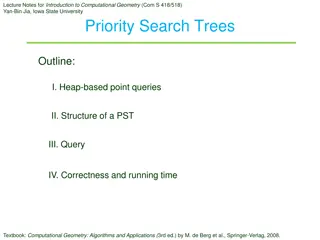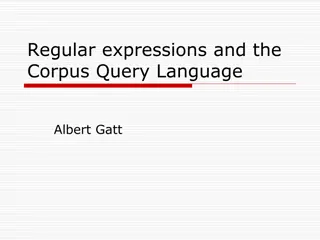Practical Tools for Corpus Search Using Regular Expressions and Query Languages
These notes explore practical tools for corpus search including regular expressions and the corpus query language (CQL/CQP). They provide an introduction to using corpora effectively for pattern identification, with examples and explanations. The guide includes information on levels of annotation and simple query syntax, along with details on accessing specific corpora for practice.
Download Presentation

Please find below an Image/Link to download the presentation.
The content on the website is provided AS IS for your information and personal use only. It may not be sold, licensed, or shared on other websites without obtaining consent from the author. Download presentation by click this link. If you encounter any issues during the download, it is possible that the publisher has removed the file from their server.
E N D
Presentation Transcript
+ Using Corpora - II Albert Gatt
+Corpus search These notes introduce some practical tools to find patterns: regular expressions A general formalism to represent finite-state automata the corpus query language (CQL/CQP): developed by the Corpora and Lexicons Group, University of Stuttgart a language for building complex queries using: regular expressions attributes and values
+A typographical note In the following, regular expressions are written between forward slashes (/.../) to distinguish them from normal text. You do not typically need to enclose them in slashes when using them.
+Practice Today we ll use two corpora: The MLRS Corpus of Maltese (v2.0) The CLEM Corpus of Learner English (v2.0) Both available on a uni server: http://mlrs.research.um.edu.mt/CQPweb (This is probably a good time to sign up if you don t have an account)
+ Simple query syntax Part 1
+Simple queries Can take the form of words or phrases: kien kien qed jiekol But this is a bit limiting. Simple queries have a (limited) pattern syntax we can exploit.
+Levels We define different levels of annotation. This depends on the corpus and what info it contains. The levels can be distinguished in the Simple Query Interface MLRS: Primary level: word Secondary level: pos CLEM: Primary level: word Secondary level: pos Tertiary annotation: lemma
+Simple Query: levels Primary level: Convention: just plain typed queries: word or phrase MLRS: kien CLEM: he was Secondary level: Preceded by an underscore MLRS: kien_VA Find instances of kien tagged as auxiliary verbs CLEM: man_NN Find instances of man tagged as nouns Can also be independent: MLRS: kien _NN = instances of kien followed by anything tagged as Noun
+Simple query: levels Tertiary level: Surrounded by curly brackets CLEM: {have} Find instances of the lemma have Returns have, having, had CLEM: {man}_NN Find instances of the lemma man tagged as noun Returns man, men
+Practice Each corpus links to its POS tagset. You need to have this in front of you! In CLEM or MLRS, try looking for: A personal pronoun followed by a verb followed by a determiner followed by a noun e.g. she ate a bun E.g. hu qatel in-nemusa In CLEM, try looking for: The pronoun it followed by the lemma result tagged as a verb followed by that.
+Simple Query Patterns There is a small number of wildcard characters. These can be used on any of the three annotation levels. ? any character b?ood blood, brood * -- zero or more characters (any) *able able, capable, manageable + -- one or more characters (any) +ata ravjulata, prinjolata, u ata (but not ata) ??+ -- three or more characters For alternatives, use square brackets ??+[ata,a ] rappurtata, rappurta
+Try some queries Remember: In MLRS, you have word and pos In CLEM, you also have lemma Try using some pattern combinations, for example: A verb group (auxiliary + main verb, etc) Specific derivations with a particular prefix/suffix A word/lemma ending in a specific suffix, tagged as a verb, followed by a pronoun An adjective, followed by a word/lemma starting with a specific prefix and tagged as a noun
+An important disclaimer The symbols used in the simple query language are similar to the ones used for full-fledged regular expressions However, in real regexes, the meaning is sometimes slightly different.
+ Regular expressions Part 2
+Regular expressions A regular expression is a pattern that matches some sequence in a text. It is a mixture of: characters or strings of text special characters groups or ranges e.g. match a string starting with the letter S and ending in ane
+The simplest regex The simplest regex is simply a string which specifies exactly which tokens or phrases you want. These are all regexes: the tall dark lady dog the
+Beyond that But the whole point of regexes is that we can make much more general searches, specifying patterns.
+Delimiting regexes Special characters for start and end: /^man/ => any sequence which begins with man : man, manned, manning... /man$/ => any sequence ending with man : doberman, policeman... /^man$/=> any sequence consisting of man only
+Groups of characters and choices /[wh]ood/ matches wood or hood [ ] signifies a choice of characters /[^wh]ood/ matches mood, food, but not wood or hood [^ ] signifies any character except what s in the brackets
+Practice Write a regular expression to match: The word beginning with l or m followed by aid This should match maid or laid [lm]aid The word beginning with r or s or b or t followed by at This should match rat, bat, tat or sat [rbst]at
+Ranges Some sets of characters can be expressed as ranges: /[a-z]/ any alphabetic, lower-case character /[0-9]/ any digit between 0 and 9 /[a-zA-Z]/ any alphabetic, upper- or lower-case character /[a-zA-Z0-9]/ any alphabetic, upper- or lower-case character, and any digit
+Practice Type a regular expression to match: a date between 1800 and 1899 18[0-9][0-9] the number 2 followed by x or y 2[xy] A four-letter word beginning with i in lowercase i[a-z][a-z][a-z]
+Disjunction and wildcards /ba./ matches bat, bad, /./ means any single alphanumeric character Compare to the simple query language character ? /gupp(y|ies)/ guppy OR guppies /(x|y)/ means either X or Y important to use (round) parentheses!
+Practice Rewrite this regex using the (.) wildcard A four-letter word beginning with i in lowercase i[a-z][a-z][a-z] i... Does it match exactly the same things? Why?
+Quantifiers (I) /colou?r/ matches color or colour /govern(ment)?/ matches govern or government /?/ means zero or one of the preceding character or group
+Practice Write a regex to match: color or colour colou?r sand or sandy sandy?
+Quantifiers (II) /ba+/ matches ba, baa, baaa /(inkiss )+/ matches inkiss, inkiss inkiss (note the whitespace in the regex) /+/ means one or more of the preceding character or group
+Practice Write a regex to match: A word starting with ba followed by one or more of characters. ba.+
+Quantifiers (III) /ba*/ matches b, ba, baa, baaa /*/ means zero or more of the preceding character or group /(ba ){1,3}/ matches ba, ba ba or ba ba ba {n, m} means between n and m of the preceding character or group /(ba ){2}/ matches ba ba {n} means exactly n of the preceding character or group
+Summary Symbol Meaning Example Matches... ^ Start of string /^wo/ woman, wombat $ End of string /man$/ woman,man, doberman [...] Any of the characters in this range or set [wh]ood Wood, hood (...) Defines a group (suit|port)able suitable, portable | A disjunction ( or ) . Any since character ..man woman, human ? One or none of the preceding colou?r color, colour + One or more of the preceding (go)+ go, gogo * Zero or more of the preceding goo*d good, god, goood {n,m} Between n and m of the preceding go{1,2}d good,god {n} Exactly n of the preceding
+Practice Write a regex to match: A word starting with ba followed by one or more of characters. ba.+ Now rewrite this to match ba followed by exactly one character. ba.{1} Re-write, to match b followed by between two and four a s (e.g. Baa, baaa etc) ba{2,4}
+ The corpus query language Part 3
+Switch to the CQL interface Under Query type, select CQP Syntax Note: CQP syntax on the MLRS/CLEM interface is identical to the CQL syntax in SketchEngine.
+CQL syntax So far, we ve used regexes to match strings (words, phrases). We often want to combine searches for words and grammatical patterns. CQL queries consist of regular expressions. But we can specify patterns of words, lemmas and pos tags. NB: What we can do depends on the levels of annotation in the corpus
+Structure of a CQL query [attribute= ... ] What we want to search for. Can be word, lemma or pos The actual pattern it should match.
+Structure of a CQL query Examples: [word= it.+ ] Matches a single word, beginning with it followed by one or more characters [pos= V.* ] Matches any word that is tagged with a label beginning with V (so any verb) [lemma= man.+ ] Matches all tokens that belong to a lemma that begins with man
+Structure of a CQL query [attribute= ... ] What we want to search for. Can be word, lemma or pos The actual pattern it should match. Each expression in square brackets matches one word. We can have multiple expressions in square brackets to match a sequence.
+CQL Syntax (I) Regex over word: [word= it ] [word= resulted ] [word= in ] matches only it resulted in Regex over word with special characters: [word= it ] [word= result.* ] [word= in ] matches it resulted/results in Regex over lemma: [word= it ] [lemma= result ] [word= that ] matches any form of result (regex over lemma)
+CQL Syntax II We can combine word, lemma and pos queries for any single word. Word and tag constraints: [word= it ] [lemma= result & pos= V.*] Matches only it followed by a morphological variant of the lemma result whose tag begins with V (i.e. a verb)
+Practice Write a CQL query to match: Any word beginning with lad [word= lad.* ] The word strong followed by any noun NB: remember that noun tags start with N [word= strong ] [tag= N.+ ]
+Practice The word strong followed by any noun [word= strong ] [pos= N.+ ] Rewrite this to search for the lemma strong tagged as adjective. NB: Adjective tags in CLEM start with JJ; in MLRS with MJ [lemma= strong & pos= JJ.* ][pos= N.+ ] The lemma eat in its verb (V) forms [lemma= eat & pos= V.* ]
+CQL syntax III The empty square brackets signify any match Using complex quantifiers to match things over a span: [word= confus.* & pos= V.* ] []{0,2} [word= by ] verb beginning with confus tagged as verb, followed by the word by, with between zero and two intervening words confused by (the problem) confused John by (saying that) confused John Smith by (saying that)
+Practice Search for the verb knock/ abbat (in any of its forms), followed by the noun door/bieb, with between zero and three intervening words: [lemma= knock & pos= V.* ][]{0,3}[word= door & pos= N.* ]
+ Counting stuff (again) Part 4
+We can count occurrences of these complex phrases Pretty much the same functionality as we saw last time in SketchEngine is available on this server. It s just located in a different place.
+A final task Choose two adjectives which are semantically similar. Search for them in the corpus (MT or EN), looking for occurrences where they re followed by a noun. Run a frequency query on the results. Generate collocations for them.

 undefined
undefined































